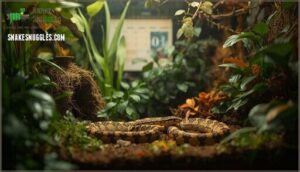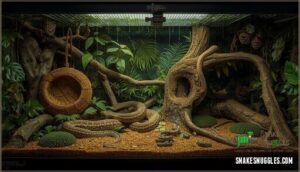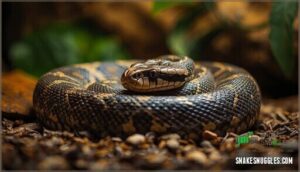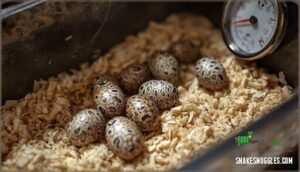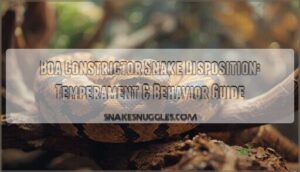This site is supported by our readers. We may earn a commission, at no cost to you, if you purchase through links.

The difference between a clutch of healthy hatchlings and months of wasted effort comes down to understanding what snakes need before, during, and after mating. Getting the species selection right, preparing adults through proper conditioning, and managing the incubation process all require specific knowledge that separates successful breeders from those who struggle.
Whether you’re drawn to ball python morphs or the vibrant patterns of corn snakes, you’ll need to master the fundamentals of reptile reproduction, from gender identification to hatchling care.
Table Of Contents
- Key Takeaways
- Choosing Snakes for Breeding
- Preparing Snakes for The Breeding Season
- Setting Up The Breeding Environment
- How Do You Get Snakes to Breed?
- Snake Reproduction and Fertilization
- Managing Nutrition for Breeding Success
- Incubating Eggs and Caring for Hatchlings
- Preventing and Managing Breeding Problems
- Frequently Asked Questions (FAQs)
- Conclusion
Key Takeaways
- Successful snake breeding depends on meeting precise physiological thresholds—female ball pythons need at least 1,200 grams and males 700 grams—because underweight animals won’t produce viable eggs regardless of their apparent receptivity.
- Temperature manipulation drives reproductive success: temperate species like corn snakes require deliberate cooling periods (brumation at 50–59°F for 2–3 months) to trigger breeding instincts, while maintaining exact incubation temperatures of 80–88°F prevents the 40% embryo failure rate caused by even minor fluctuations.
- Genetic management separates successful breeders from those who struggle—inbreeding depression can spike embryo mortality by 40–60%, so you’ll need lineage tracking and outcrossing every 3–4 generations to maintain viable offspring.
- Post-mating care directly impacts future breeding success: females must regain 10–15% body mass through strategic feeding before rebreeding, and egg binding (affecting up to 30% of females) can be prevented through calcium supplementation, proper humidity control, and thermal regulation.
Choosing Snakes for Breeding
Successful snake breeding starts with the right foundation—healthy animals with compatible genetics and verifiable lineage. You’ll need to confirm the sex of your breeding pair and choose species that match your experience level and resources.
Let’s walk through what matters most when selecting your breeding stock.
Popular Pet Snake Species
Picking the right species sets the stage for everything that follows. You’ll want snakes bred by thousands of hobbyists with proven success rates. Here are three species that dominate the breeding scene:
- Ball pythons – Over one million live in captivity worldwide, offering dozens of morphs and predictable temperaments at 3–5 feet long.
- Corn snakes – Second most popular, with vibrant colors and manageable 4–6 foot sizes perfect for beginners.
- Boa constrictors – Larger at 10+ feet but rewarding for experienced breeders seeking impressive offspring.
Consider that these snakes are frequently searched for as pets.
Selecting Healthy Breeders
Once you know which species fits your goals, you need animals with rock-solid health. Female ball pythons should weigh at least 1,200 grams, usually reached between 2–3 years of age. Males need 700 grams minimum, usually achieved by 8 months. Physical condition matters just as much as numbers on a scale. Before introducing a new snake for breeding, consider a reptile health screening to rule out any underlying issues.
| Health Criteria | What to Look For |
|---|---|
| Weight requirements | Females ≥1,200g; Males ≥700g |
| Physical condition | Bright eyes, smooth skin, no visible ribs |
| Feeding consistency | Regular meals accepted without hesitation |
| Genetic screening | Lineage records; avoid known hereditary issues |
| Ethical considerations | No morph-associated deformities or chronic disease |
Look for bright, clear eyes and smooth skin free of scars or lesions. A proper body should feel firm and plump, without visible ribs or spine projections. Regular feeding consistency before breeding signals stable health and readiness for reproduction.
Genetic screening through lineage records prevents pairing related individuals, which tanks offspring viability and causes heritable health issues. Avoid snakes with chronic disease or morph-linked deformities—prioritize animal welfare over novelty every time.
Gender Identification Techniques
You can’t breed snakes without knowing who’s male and who’s female. Cloacal probing inserts a smooth metal rod into the cloaca—males probe 6–8 subcaudal scales deep, females only 1–3. Accuracy runs around 81.5%.
The popping technique works on juveniles under 12 months, gently everting hemipenes to confirm males. Ultrasound imaging gives 100% accuracy and causes zero stress.
Molecular sexing uses PCR on shed skin or blood, delivering results in 4–6 hours with 98% accuracy.
Visual assessment checks tail length and subcaudal scale count—correct 70–80% of the time, but always verify with a snake sexing probe or imaging.
Genetic and Lineage Considerations
Once you confirm sex, your next concern should be the genetic makeup of your breeding pair. Genetic Diversity protects against Inbreeding Depression, which can spike embryo mortality 40–60% in closed breeding systems. Morph Inheritance follows predictable patterns—breeding two heterozygotes for a recessive trait like albinism yields 25% visible offspring. Lineage Tracking records carrier status and prevents accidental pairings between related snakes.
- Ball pythons show over 400 morphs; breeding two “het” carriers gives 25% homozygous recessive offspring
- Inbreeding Avoidance requires outcrossing every 3–4 generations to maintain Genetic Health
- Genetic mutations controlling color sometimes affect neurological function when linked genes are involved
- Maintaining 50–100 unrelated breeders per species reduces inbreeding depression risk
- Molecular tools like microsatellite markers reveal hidden genetic variation between wild and captive lines
Preparing Snakes for The Breeding Season
Getting your snakes ready for breeding season isn’t something you just wing—it takes deliberate preparation to trigger their reproductive instincts. You’ll need to recreate the environmental shifts they’d experience in the wild, from temperature drops to light changes.
Here’s what you need to focus on to prepare your snakes properly.
Mimicking Natural Cooling (Brumation)
Most temperate species need a cooling period—brumation—to trigger breeding instincts. For colubrids, gradually drop the temperature from 18°C to 10–15°C (50–59°F) over one to two weeks. Use wine coolers or temperature-controlled chambers with thermostats to prevent dangerous drops below 5°C. Maintain humidity between 30–60% and provide constant hydration.
Western hognose snakes brumate for three months; eastern varieties need two. Monitor weight weekly—losses beyond 10% signal trouble. Always schedule veterinary checks before and after seasonal shifts to catch hidden health issues.
Adjusting Light and Photoperiod
Once brumation ends, photoperiod management becomes your next lever. Snakes use light spectrum and duration as environmental cues for reproductive timing—melatonin regulation drives this.
Start with 8–10 hours of lighting during cooling, then gradually increase to 12–14 hours over four to six weeks as temperatures rise. Automated systems with timers prevent inconsistencies.
These seasonal shifts, combined with brumation effects, synchronize hormonal readiness and trigger courtship behaviors in most temperate species.
Managing Feeding Schedules
Feeding schedules must shift as you approach pairing. Increase meal frequency two to three months before brumation—females need 10–20% more food volume to fuel ovulation. Males stay leaner; overfeeding suppresses their drive. Then fast both for two to three weeks before cooling begins.
Post-brumation, start with smaller prey once weekly, building back gradually. Hatchlings eat every five to seven days, juveniles every seven to ten, adults every ten to fourteen—species variations matter. Ball pythons stretch to 21 days; hognoses stay tighter at five to seven.
Track body condition closely; breeding performance drops when snakes carry excess weight or insufficient reserves.
Monitoring Health and Weight
Weight tracking isn’t optional—it’s your first line of defense against breeding failure. Weigh your snakes monthly using a digital gram scale, watching for the normal 10% seasonal swing. Females dropping 10–20% during egg production is expected, but sudden losses signal trouble.
Monitor these indicators closely:
- Body condition: Check muscle tone and spine visibility using condition scoring systems
- Reproductive readiness: Look for consistent appetite, clear eyes, and normal sheds
- Hydration levels: Maintain 40–60% humidity to prevent dehydration and egg retention
- Digital records: Log weight trends, feeding, and breeding data to spot patterns early
Discharge, swelling, or appetite changes demand immediate veterinary attention—reproductive infections move fast.
Setting Up The Breeding Environment
Creating the right breeding environment isn’t just about picking a cage—it’s about balancing several factors that work together to trigger and support reproduction. Temperature, humidity, space, and lighting all play specific roles in signaling your snakes that conditions are right for breeding.
Here’s what you need to dial in before introducing your breeding pair.
Temperature and Humidity Control
You’ll need to dial in both enclosure temperature and humidity levels with precision—think of it as calibrating a life-support system for embryonic development. Ideal environmental parameters include daytime temperatures of 80–85°F and nighttime drops to 70–75°F, while humidity levels should hold steady between 40–60% during most breeding stages. Your basking zone must reach 88–92°F to support follicular development and mate recognition.
Temperature and humidity control becomes critical during incubation, where even a 4°F fluctuation can cause 40% embryo failure. Use monitoring equipment like digital thermostats and hygrometers to track these conditions continuously. Humidity gradients matter too—tropical species need 70–80% humidity to prevent dehydration and support seasonal adaptation.
Here’s what different breeding stages demand:
| Breeding Stage | Temperature Range | Humidity Level |
|---|---|---|
| Courtship & Mating | 82–84°F daytime | 40–60% |
| Female Ovulation | 90–92°F basking zone | 50–65% |
| Post-Laying | 82–86°F | 60–80% (raised) |
| Incubation | 82–88°F (consistent) | 55–65% |
| Hatching & Acclimation | Gradual reduction | Gradual reduction |
Automated systems reduce egg mortality by 25–35% compared to manual adjustments, giving you consistent results across clutches.
Cage Size and Layout
Your breeding enclosure setup is about more than just square footage—it’s about creating microhabitats that encourage natural behaviors and reproductive success. For most 3–5 ft breeding snakes like corn snakes or ball pythons, you’ll want at least 48″L × 24″W × 24″H, meeting minimum dimensions that allow unrestricted movement.
Cage size should allocate 30–40% open floor space for exercise while incorporating vertical branches for semi-arboreal species. Secure lids with locking mechanisms prevent escapes, and modular layouts let you adjust internal components between pairing and post-mating isolation.
Nesting privacy requires strategically placed retreat zones away from high-traffic areas. Substrate depth of 2–3 inches facilitates burrowing and maintains humidity gradients critical for gravid females.
Creating Hiding Spots and Nest Boxes
Beyond cage dimensions, your snakes need secure retreats to stay calm. Snakes with multiple hiding spots show up to 40% stress reduction compared to those exposed in open layouts. You’ll want at least two hides per snake—one warm-side, one cool-side—to support thermoregulation without forcing visibility.
For nesting areas, nest box substrates like sphagnum moss offer antimicrobial properties that cut egg spoilage by roughly 15%.
Environmental brain enrichment through hiding spots, branches, and clutter actually increases brain volume in sensory regions. Welfare space needs tie directly to enclosure setup complexity, not just size.
Ventilation and Lighting Essentials
Air circulation keeps ammonia and CO₂ from building up—poor ventilation means respiratory trouble. Your snake enclosure needs vents on opposite sides: lower ones on the cool end, upper ones on the warm side, creating natural convection airflow. A 6×2×2 ft terrarium should have at least three vents per end.
Pair that ventilation design with a 12-hour lighting schedule to sync feeding and breeding cycles. UVB exposure—even 6–8 hours at 2–5%—improves calcium metabolism and egg calcification, ensuring proper ventilation and lighting for breeding success.
How Do You Get Snakes to Breed?
Once you’ve prepared your snakes through cooling and conditioning, you need to bring them together at the right moment.
The breeding process involves careful introductions, close observation of behavior, and timing that respects each snake’s readiness.
Here’s how you guide your snakes through successful mating while keeping stress low and safety high.
Introducing Mates Safely
Regarding pairing compatibility, your success starts with solid quarantine protocols and a controlled introduction. Use this checklist:
- Quarantine both snakes for 30–60 days.
- Vet check and fecal testing.
- Controlled introduction—supervise for 5–10 minutes.
- Behavioral observation—watch for aggression and use pheromones to prevent bites.
Smart mate selection means safer snake mating.
Recognizing Mating Behaviors
Once introductions go smoothly, watch for courtship rituals like chin rubbing, body jerks, and synchronized undulation. Male competition may spark wrestling or neck raising.
Pheromone detection triggers tongue flicking and trail following. Copulation duration can stretch from minutes to hours.
Receptivity signals—reduced movement or tail quivering—show the female’s readiness, guiding you through the snake mating process.
Pheromone Trails and Mate Attraction
When you’re breeding snakes, pheromone trails play a starring role in mate attraction. Thanks to VNO detection and complex pheromone chemistry, males track female scent with precision.
Seasonal regulation boosts pheromone output, guiding the mating process. Species specificity ensures only the right partners respond, while mimicry tactics—like males emitting female scents—add another layer to snake mating behavior.
Preventing Premature Mating
As seasonal shifts kick off hormonal changes, keep snakes in separate housing to prevent surprise pairings. Visual barriers and olfactory control—like cleaning pheromone traces—help manage stress and enforce the right mating cycle.
Pheromone management delays advances until true breeding readiness. Hold off on introducing pairs until both show sexual maturity, then let nature’s timing work in your favor.
Snake Reproduction and Fertilization
Understanding how snakes reproduce can help you plan each step of the breeding process. From fertilization to egg-laying, their methods can surprise you.
Let’s walk through the different ways snakes bring new life into the world.
Internal Fertilization Process
Ever wondered how snakes pull off fertilization so efficiently? It’s a fascinating blend of specialized reproductive anatomy and behavioral timing. You’ll see:
- Hemipenes Morphology designed for secure Sperm Transfer
- Cloacal Anatomy enabling fluid connection
- Perfect Fertilization Timing for egg fertilization
- Mating plug (copulatory plugs) that block rivals
- Female sperm storage that allows fertilization long after mating
Oviparous Vs. Ovoviviparous Species
Think of snake reproduction like nature’s double-play: some species champion Egg Laying (oviparous), others favor Live Birth (ovoviviparous)—each an evolutionary answer to their habitat. Egg-laying snakes thrive in warm climates; live-bearers evolved for colder or wetter zones. Reproductive Frequency and offspring output vary, reflecting deep Climate Adaptations in every clutch or litter.
| Snake Species | Egg Laying | Live Birth |
|---|---|---|
| King Cobra | Yes | No |
| Sea Snake | No | Yes |
| Corn Snake | Yes | No |
| Boa Constrictor | No | Yes |
| Garter Snake | Some | Some (varies by locale) |
Parthenogenesis in Snakes
Did you know some snakes skip the need for a mate altogether? Parthenogenesis—true asexual snake reproduction—lets females produce offspring solo. Here’s what makes it noteworthy:
- Automixis Mechanisms restore diploidy.
- Taxonomic Distribution spans boas to pythons.
- Genetic Outcomes: increased homozygosity.
- Evolutionary Implications for isolated populations.
- Research Significance drives conservation insights.
Sperm Storage Mechanisms
Did you realize female snakes can store sperm for years, quietly shaping their reproductive timeline? SST morphology in their reproductive anatomy lets them maintain sperm longevity, supporting asynchronous mating and boosting genetic diversity.
This natural adaptation in reptile reproduction inspires cryopreservation research, allowing fertilization to happen long after mating—an elegant solution for successful snake reproduction.
Managing Nutrition for Breeding Success
Nutrition plays a key role in getting your snakes ready for breeding. You’ll need to pay close attention to what goes into their diet and how you feed them.
Here’s what to focus on for healthy, successful breeding.
Protein and Whole-Prey Diets
Nutrition forms the backbone of breeding success. Protein intake is crucial—crude protein between 30–50% fosters muscle growth and fertility. Whole-prey composition, like mice, delivers balanced amino acid roles for reproductive health.
Pre-Killed Safety matters, too; it prevents injuries and disease. Adjust feeding frequency to match species and condition, keeping dietary requirements for breeding snakes front and center.
Vitamin and Mineral Supplementation
Once you’ve dialed in whole-prey diets, it’s time to fine-tune with supplements. Calcium:Phosphorus Ratio matters—aim for 2:1 to avoid malnutrition and calcium deficiency. Vitamin D3 synthesis is limited indoors, so dietary sources help. Watch your supplementation schedules: excess vitamin A toxicity and high selenium levels can harm snakes. Here’s what matters most:
- Calcium:Phosphorus Ratio
- Vitamin D3 Synthesis
- Vitamin A Toxicity
- Selenium Levels
- Supplementation Schedules
Feeding Strategies for Females
Once you’ve balanced supplements, it’s time to focus on female feeding strategies. Boost pre-breeding weight by 10–15% with food cycling—smaller, frequent meals spark follicular development. During gestation, switch to modest prey sizes and stretch intervals. Post-laying recovery benefits from energy-dense snacks.
Here’s a quick guide:
| Phase | Feeding Approach |
|---|---|
| Pre-breeding | Food cycling, weight up |
| Gestation | Smaller prey, less often |
| Post-laying | Energy-dense, frequent |
Preventing Egg Binding and Health Issues
Once females start cycling, your next challenge is egg binding and health issues. Calcium deficiency and malnutrition are the usual suspects, so keep up with supplements and whole-prey diets.
Humidity control matters—set up a moisture-rich lay box to reduce stress. If you spot swelling or restlessness, don’t wait; a veterinarian can intervene before things get serious.
Incubating Eggs and Caring for Hatchlings
Once your snakes have laid their eggs, the next step is to create the right environment for incubation. How you set up your incubator can make all the difference for healthy hatchlings.
Here are some common enclosure options to think about.
Setting Up Incubators
Your incubator needs a stable foundation—think of it as a controlled microclimate where precision trumps guesswork. Set internal temperatures between 80–88°F using digital thermostats accurate to ±0.5°F for reliable egg incubation.
Insulate walls with polystyrene or high-density plastics to maintain consistent heat. Place substrates like perlite or vermiculite in containers with adjustable ventilation holes for proper humidity balance and gas exchange.
Position temperature probes at egg level without direct contact, ensuring your incubators provide best incubation conditions for reptile eggs throughout development.
Maintaining Proper Temperature and Humidity
You’ll need precise temperature control within 80–85°F to improve embryonic development across most breeding species. Temperature gradients outside ±1°F or humidity swings beyond ±5% reduce hatch success considerably, so equipment calibration and consistent humidity management become non-negotiable for reliable results.
Humidity monitoring should maintain levels between 60–70% using calibrated digital hygrometers to prevent desiccation or fungal growth. Check substrate moisture daily—proper vermiculite ratios guarantee incubation stability.
Monitoring Egg Development
Throughout egg incubation, you’ll track viability indicators using candling or ultrasonography techniques to detect embryonic stages early—fertile eggs show consistent heart activity by days 10–14. Infertile eggs lack translucence and rhythmic heartbeats, signaling removal to protect viable clutchmates during hatching.
Temperature correlation with development rate means consistent 80–85°F readings prevent deformities, while humidity dynamics between 60–70% stop desiccation.
First Feeding and Early Care of Hatchlings
After the shedding process wraps up—generally 7–14 days post-hatching—you’re ready to offer the first feeding. Most hatchlings accept newborn mice (pinkies) sized to match body diameter, though some species need scented prey or lizards to trigger appetite. Hydration needs stay critical during this window, so provide shallow water dishes and moist hides to support hatchling development.
- Prey size matters: Feed items equal to 10–15% of body weight to avoid regurgitation
- Housing setup prevents stress: Individual enclosures eliminate feeding competition and handling stress
- Temperature stability drives success: Maintain 80–85°F with 60–70% humidity for reptile hatchlings’ first feeding and care
Preventing and Managing Breeding Problems
Breeding snakes doesn’t always go as planned, and knowing how to spot and fix problems can make the difference between success and setback. Issues like stress, egg binding, and infertile clutches can derail your efforts if you’re not prepared.
Here’s what to watch for and how to handle the most common breeding complications.
Stress and Disease in Breeding Snakes
Breeding snakes taxes their immune system heavily, making them vulnerable to infections and environmental stressors. Male ball pythons, for instance, develop cloacal infections at rates near 13% annually during breeding cycles. Stress hormones like corticosterone spike from poor handling or overcrowding, suppressing immune defenses and delaying reproduction.
You’ll also face parasites, respiratory problems, and bacterial diseases when conditions slip. Preventative strategies matter: maintain strict temperature control, quarantine new animals for 60 days, and minimize handling. Regular veterinarian checks catch issues early, protecting your investment and your animals’ welfare.
Egg Binding and Prolapse Issues
Egg binding—called dystocia—strikes up to 30% of female reptiles under poor husbandry. Calcium deficiencies, low vitamin D, and temperature mismanagement weaken muscle contractions, trapping eggs inside. You’ll spot anorexia, straining, or palpable masses. Diagnostic methods include radiographs and ultrasound. Surgical interventions like salpingotomy save snakes when oxytocin fails.
Cloaca prolapses affect females 7.5 times more than males, often from chronic straining.
Breeder management—calcium supplementation, proper nesting boxes, and thermal control—prevents these emergencies in reptile breeding.
Infertile or Rotten Eggs
Even healthy matings produce infertile eggs—called “slugs”—in 10–30% of clutches. You’ll catch them with egg candling between days 5–10: fertile eggs show red blood vessels, while infertile ones stay yellow and translucent.
Eggs rotting in captivity stem from microbial infections—Aspergillus, Fusarium, or bacteria like Pseudomonas—especially when humidity levels exceed 90% or temperature control falters.
Prevention strategies include sanitizing containers with 10% bleach, maintaining 75–85% humidity, and removing compromised eggs immediately to protect egg development.
Post-Breeding Recovery and Ongoing Care
After addressing infertile eggs, your female snake needs proper postmating care and recovery time to regain strength. Reduce refeeding strategies to once every 10–14 days—ball pythons usually resume feeding 1–2 weeks post-laying.
Schedule veterinary exams within two weeks to catch complications early and reduce infection risk by 40%. Implement quarantine protocols for 4–6 weeks to prevent pathogen spread. Enclosure sterilization with reptile-safe disinfectants is non-negotiable between breeding cycles.
Weight monitoring ensures females regain 10–15% body mass before rebreeding, directly improving future breeding success and postmating care outcomes while protecting snake health during breeding.
Frequently Asked Questions (FAQs)
What permits are required for breeding snakes?
Most states require permits for commercial snake breeding or selling native and exotic snake species. Federal regulations apply if you’re working with endangered species under the ESA or shipping across state lines.
Shipping compliance includes health certificates from licensed veterinarians, ensuring your captive breeding program meets animal welfare standards.
How long does snake egg incubation take?
Most species hatch in 45–70 days, but temperatures impact incubation times directly. Ball pythons take 55–60 days, while corn snakes need 60–65 days.
Humidity’s effects on egg hatching and hatchling health are critical for success.
Can different snake species interbreed successfully?
Different snake species can hybridize in captivity, but genetic compatibility issues usually arise. Hybrid snakes often show reduced fertility and survival rates.
Reproductive isolation mechanisms generally prevent successful interbreeding, though documented hybridization cases exist in captive breeding programs.
What are common snake breeding morph combinations?
Popular combinations include dominant morphs like Spider bred to normals, producing 50% Spider offspring.
Recessive combinations such as two Albino carriers yield 25% Albino young.
Co-dominant traits like Pinstripe create varied phenotypes in predictable ratios.
How do you determine snake breeding maturity?
You’ll know your snake is ready to breed by checking three things: age thresholds, weight minimums, and hormonal indicators. Most snakes reach sexual maturity between two and four years old, but each breeding male and breeding female also needs proper weight and length before mating safely.
Conclusion
A single mistake in brumation timing or egg humidity can mean the difference between a thriving clutch and complete reproductive failure. The stakes are real when you’re managing how to breed pet snakes—you’re responsible for new lives, not just following a checklist.
Master weight thresholds, cooling cycles, and incubation precision, and you’ll join breeders who consistently produce healthy hatchlings. Skip the fundamentals, and you’ll watch months of preparation collapse. Your success hinges on details most people overlook until it’s too late.
- https://reptilesupershow.com/mastering-snake-breeding-tips-for-healthy-serpents/
- https://incubatorwarehouse.com/pages/reptile-incubation-time-and-temperature
- https://reptifiles.com/boa-constrictor-care/boa-constrictor-temperatures/
- https://www.petplace.com/article/reptiles/general/snake-egg-incubation
- https://pmc.ncbi.nlm.nih.gov/articles/PMC11591334/

